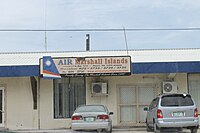Delap-Uliga-Djarrit
[6] As with the rest of the Marshalls, Majuro was captured by the Imperial Japanese Navy in 1914 during World War I[6] and mandated to the Empire of Japan by the League of Nations in 1920.
[citation needed] In 1940, Japan built a seaplane base in the leeward part of the east of the atoll, located primarily on Djarrit.
This choice of location was motivated by the lagoon being suitable for large ships, and the presence of patch reefs in the west, which made seaplane activities dangerous.
[6][7] United States troops landed on the atoll on January 31, 1944 and promptly began building the major Naval Base Majuro, finished later that year.
[5][8][7] American forces set up and improved infrastructure, including a runway covering much of Delap (Majuro Airfield), and military headquarters at Uliga and Djarrit.
[6] As of early 1944, about 400 people lived in small villages in Delap and Djarrit, while Uliga was not reported as being inhabited.
[14] On September 15, 2007, Witon Barry, of the Tobolar Copra processing plant in the Marshall Islands' capital of Majuro, said power authorities, private companies and entrepreneurs had been experimenting with coconut oil as an alternative to diesel fuel for vehicles, power generators, and ships.
The Cathedral of the Assumption of the Roman Catholic Apostolic Prefecture of the Marshall Islands[17] and Baet-Ul-Ahad Mosque are located in town center.
[18][19] The country's only other major hospital is on Ebeye Island, the Leroij Kitlang Memorial Health Center.
[citation needed] The Marshall Islands High School is near the north end of the town.





